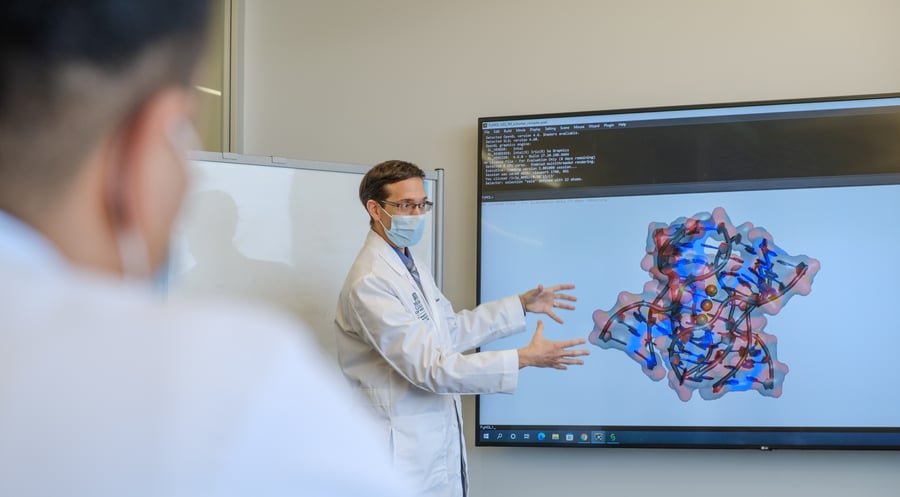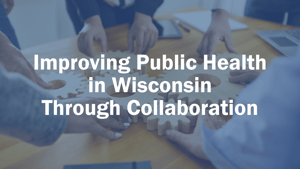Creating Wisconsin's First Cancer Precision Medicine Simulation Unit
September 23, 2022 Posted by Jesse M. Ehrenfeld, MD, MPH

To learn more about this funded project, click here
The sequencing of the human genome has allowed medical researchers to identify genetic variants associated with certain diseases, fueling new diagnostic methods rooted in data revealed by genetic testing. Much work remains to be done, however, to integrate this new technology into routine patient care. And with the help of funding from the Advancing a Healthier Wisconsin Endowment, researchers at the Linda T. and John A. Mellowes Center for Genomic Sciences and Precision Medicine (“Mellowes Center”) at the Medical College of Wisconsin (MCW) are working to understand and visualize the relationship between genes, health, the environment, and human wellness to better diagnose and treat rare diseases.
A More Precise Model
MCW Department of Surgery Professor and Mellowes Center Director Raul Urrutia, MD, explains that the current standard for genomic diagnosis is based upon information obtained from a patient’s linear DNA sequence. “However,” Dr. Urrutia notes, “we know this linear coding in the gene makes molecules in 3-D that work like nano machines.”
Dr. Urrutia and his colleagues at the Mellowes Center are working to realize the untapped potential of precision medicine for patients in Wisconsin and beyond through the development of high-resolution phenotypes that will enable the next generation of data interpretation.
“Quite often, people who have an undiagnosed disease – sometimes called a rare disease – they don’t even know [if] what they have is real, because there’s no diagnosis,” relates MCW Associate Director of Bioinformatics and Data Science Michael Zimmermann, PhD. “We can tell them, this is what happened [to you]. To actually give a name to [the disease] is a very meaningful thing for the patient.”
Through 3-D modelling, researchers at the Mellowes Center can take syndromes, which are a collection of phenotypes or traits, and identify how a genetic variant in the patient disrupts function to cause a specific disease. The diagnosis provides peace of mind to patients, Zimmermann notes, because it names what affects them and helps explain why they have their particular phenotype.
Dr. Zimmerman continues, “We’re able, through clinical genetics, to get that variant that has a high suspicion and then to apply the tools we have for the 3-D simulation of what happens over time to these proteins, and to give a better sense of why – not only what happened, but why.”
By better understanding the role that genes play in the development of rare diseases, researchers and health care providers can better individualize the treatments they develop for patients, increasing the chances of success.
Drawing Attention and Talent to Wisconsin
As the first precision medicine simulation unit in Wisconsin and one of only a few in the U.S., the Mellowes Center for Genomic Sciences and Precision Medicine is drawing global attention for its transformational work in 3-D genomics.
“We have connected Wisconsin with a national and international network of experts in genomic science and precision medicine and data science, so as to bring more talent to the area and be connected to the world,” observes Dr. Urrutia.
Work being done at the center, Dr. Urrutia adds, is creating new fields of study and career opportunities for medical practitioners attending the Medical College of Wisconsin. Exciting new degree programs spun out of this research include a master’s degree in genetic counselling and a master’s degree in precision medicine. The development of a master’s degree in genomic analysis is also planned.
“In other words, 3-D genomics not only influences medicine, but it also brings new jobs to the new generation in order to change and improve health in Wisconsin,” Dr. Urrutia explains.
The Mellowes Center team is leveraging AHW funding not only to build its own team, but also to create and strengthen collaboration opportunities with hospital partners and organizational allies, including the Clinical Translational Science Institute of Southeast Wisconsin and the MCW Cancer Center Office of Clinical Trials.
Return on Investment
Referencing the unique opportunity created with the help of AHW funding, Dr. Zimmerman notes, “The AHW Endowment grant has helped us to build a platform. So, what we’ve been able to do takes our experience in precision oncology, takes our experience in the undiagnosed diseases, and we’ve been able to build a process that is supporting both of them. And that’s something that’s difficult to fund through some of the traditional venues that are very disease focused.”
Dr. Urrutia adds, “We are very grateful for the support of a multi-year investment from the Advancing a Healthier Wisconsin Endowment, which [is] allowing us to push the frontiers of genomic beyond where they were ever before.”
Reflecting on AHW’s $4 million, four-year investment in this project in a recent meeting of the MCW Research and Education Advisory Committee, one of AHW’s governing bodies, AHW Director Jesse Ehrenfeld, MD, MPH, expressed enthusiasm for the promise of Dr. Urrutia and team’s work to change clinical practice in a transformative way. “Overall, AHW couldn’t be more pleased with this project’s success and their impact on collaborative, multidisciplinary efforts to advance Wisconsin’s health,” said Dr. Ehrenfeld.
Watch to learn more about how Dr. Raul Urrutia and team are developing, optimizing, and implementing new methods for genomic diagnoses.




